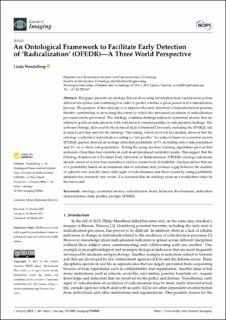| dc.contributor.author | Wendelberg, Linda | |
| dc.date.accessioned | 2021-03-23T08:05:41Z | |
| dc.date.available | 2021-03-23T08:05:41Z | |
| dc.date.created | 2021-03-20T17:17:06Z | |
| dc.date.issued | 2021 | |
| dc.identifier.citation | Journal of Imaging. 2021, 7 (3), . | en_US |
| dc.identifier.issn | 2313-433X | |
| dc.identifier.uri | https://hdl.handle.net/11250/2734947 | |
| dc.description.abstract | This paper presents an ontology that involves using information from various sources from different disciplines and combining it in order to predict whether a given person is in a radicalization process. The purpose of the ontology is to improve the early detection of radicalization in persons, thereby contributing to increasing the extent to which the unwanted escalation of radicalization processes can be prevented. The ontology combines findings related to existential anxiety that are related to political radicalization with well-known criminal profiles or radicalization findings. The software Protégé, delivered by the technical field at Stanford University, including the SPARQL tab, is used to develop and test the ontology. The testing, which involved five models, showed that the ontology could detect individuals according to “risk profiles” for subjects based on existential anxiety. SPARQL queries showed an average detection probability of 5% including only a risk population and 2% on a whole test population. Testing by using machine learning algorithms proved that inclusion of less than four variables in each model produced unreliable results. This suggest that the Ontology Framework to Facilitate Early Detection of ’Radicalization’ (OFEDR) ontology risk model should consist of at least four variables to reach a certain level of reliability. Analysis shows that use of a probability based on an estimated risk of terrorism may produce a gap between the number of subjects who actually have early signs of radicalization and those found by using probability estimates for extremely rare events. It is reasoned that an ontology exists as a world three object in the real world. | en_US |
| dc.language.iso | eng | en_US |
| dc.publisher | MDPI | en_US |
| dc.rights | Navngivelse 4.0 Internasjonal | * |
| dc.rights.uri | http://creativecommons.org/licenses/by/4.0/deed.no | * |
| dc.subject | Ontology | en_US |
| dc.subject | Ontology | en_US |
| dc.title | An Ontological Framework to Facilitate Early Detection of ‘Radicalization’ (OFEDR)—A Three World Perspective | en_US |
| dc.type | Peer reviewed | en_US |
| dc.type | Journal article | en_US |
| dc.description.version | publishedVersion | en_US |
| dc.subject.nsi | VDP::Informasjons- og kommunikasjonsteknologi: 550 | en_US |
| dc.subject.nsi | VDP::Information and communication technology: 550 | en_US |
| dc.source.pagenumber | 27 | en_US |
| dc.source.volume | 7 | en_US |
| dc.source.journal | Journal of Imaging | en_US |
| dc.source.issue | 3 | en_US |
| dc.identifier.doi | doi.org/10.3390/jimaging7030060 | |
| dc.identifier.cristin | 1899624 | |
| dc.description.localcode | This is an open access article distributed under the Creative Commons Attribution License which permits unrestricted use, distribution, and reproduction in any medium, provided the original work is properly cited | en_US |
| cristin.ispublished | true | |
| cristin.fulltext | postprint | |
| cristin.qualitycode | 1 | |

